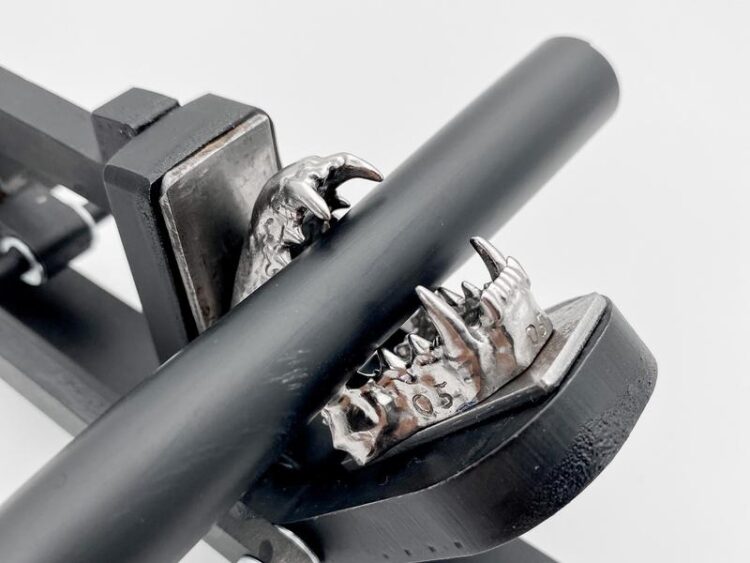Research against marten damage

The test stand modeled on a real marten's denture.
Hochschule Hof
With an innovative research project, Hof University of Applied Sciences has declared war on one of the biggest annoyances of German motorists: marten damage. At the Institute for Applied Biopolymer Research (ibp) at Hof University of Applied Sciences, headed by Prof. Dr. Michael Nase, in cooperation with the automotive supplier UNIWELL Rohrsysteme GmbH & Co. KG, materials are currently being investigated and tested that are expected to withstand the bite of the common marten far better than the materials currently used in standard hoses. The market for these materials is huge – as is the interest of the automotive industry.
According to the major German insurers, martens cause damage to motor vehicles of around 60 million euros every year – only in Germany. Every year, over 200,000 cases are reported to insurance companies, which pay for the marten damage caused. According to David Krieg from Naila in the region of Oberfranken, who is in charge of the project, this immense damage balance is expected to be significantly reduced in the near future. Krieg and his colleague Rafael Erdmann are therefore researching a truly effective solution to this common problem in the institute’s technical centers and laboratories.
Wanted: Cost-effective Solutions
Their starting point is what so often falls victim to the marten: the hoses of the engine interior. “Our goal is to develop hoses made of an inexpensive mass plastic, which on the one hand has the same properties as PVC and on the other hand offers better protection against marten bites”. Although PVC itself is basically very well suited for the production of such hoses due to its thermal and mechanical properties, it forms hydrogen chloride during recycling due to its chemical composition. Other, equally bite-resistant plastics are currently too expensive for industrial use. Hence, there is a gap in the market that needs to be filled.
Since July 2019, Krieg and his team have therefore been mixing and modifying bulk plastics to achieve the desired result and make the parts used in automobiles significantly more resistant, while still providing a cost-effective solution.
Melting point as a challenge
In the meantime, over 200 different samples from 35 material mixtures have been developed and tested. “We use the technique of radiation crosslinking to modify the materials, so we irradiate them,” says Krieg. This is done with the backround of using as few additives and other admixtures as possible to modify the properties of the plastics. Significant progress has already been made, but the melting point of the finished products, that is still too low, is the biggest hurdle for the industrial use of the solutions found. By the end of the project in the middle of next year, a solution should have been found, David Krieg is optimistic.
Of course, the interest in the research results was huge right from the start. Accordingly, the project is financed by the German Federation of Industrial Research Associations (AiF), an industry-supported network for the promotion of research, transfer and innovation in medium-sized companies.
In any case, the meticulousness with which the young researchers have worked to verify the success of their plastics research in a scientifically sound manner is impressive. “Together with the Biological Institute Oldenburg, we have therefore determined the average teeth of the beech marten and its bite force and built ourselves a bite test stand,” Krieg says with a smile. Milled from a bone-like material used in dental technology, the marten’s teeth are now attached to a suspension and then they bite – controlled by a computer – into different kinds of tubes.
How firm is firm to bite?
But how many bites must a good tube withstand to be considered “marten-proof”? Hof also tries to give a right answer to this question. The tubes that are currently available in most cars are therefore also exposed to the marten’s teeth. “This is how we find our reference value and how we can see whether our materials have better properties,” says the young researcher.
Of course, they do not want to rely just on the quality of the material in the fight against marten damage. In the future in addition to the improved biting properties of the tubes, these are going to have a marten-repellent layer on their surface.
Wissenschaftliche Ansprechpartner:
Prof. Dr. Michael Nase
Hochschule Hof
Alfons-Goppel-Platz 1
95028 Hof
Fon: +49 (0) 9281 / 409 4730
E-Mail: michael.nase@hof-university.de
Media Contact
All latest news from the category: Materials Sciences
Materials management deals with the research, development, manufacturing and processing of raw and industrial materials. Key aspects here are biological and medical issues, which play an increasingly important role in this field.
innovations-report offers in-depth articles related to the development and application of materials and the structure and properties of new materials.
Newest articles

A universal framework for spatial biology
SpatialData is a freely accessible tool to unify and integrate data from different omics technologies accounting for spatial information, which can provide holistic insights into health and disease. Biological processes…

How complex biological processes arise
A $20 million grant from the U.S. National Science Foundation (NSF) will support the establishment and operation of the National Synthesis Center for Emergence in the Molecular and Cellular Sciences (NCEMS) at…

Airborne single-photon lidar system achieves high-resolution 3D imaging
Compact, low-power system opens doors for photon-efficient drone and satellite-based environmental monitoring and mapping. Researchers have developed a compact and lightweight single-photon airborne lidar system that can acquire high-resolution 3D…





















